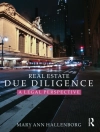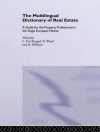Urban design enables better places to be created for people and is
thus seen in Urban Design in the Real Estate Development
Process as a place-making activity, rather than the application
of architectural aesthetics. Urban design policy can change the
‚decision environment‘ of developers, financiers, designers and
other actors in the real estate development process to make them
take place-making more seriously.
This book reports diverse international experience from Europe
and North America on the role and significance of urban design in
the real estate development process and explores how higher quality
development and better places can be achieved through public
policy.
The book is focused on four types of policy tool or instrument
that have been deployed to promote better urban design: those that
seek to shape, regulate or provide stimulus to real estate markets
along with those aim to build capacity to achieve these. Urban
design is therefore seen as a form of public policy that seeks to
steer real estate development towards policy-shaped rather than
market-led outcomes. The editors set the examples, case studies and
evidence from international contributors within a substantive
discussion of the impact of urban design policy tools and actions
in specific development contexts.
Contributions from leading urban design theorists and
practitioners explore how:
* Masterplanning and infrastructure provision encourage high
quality design
* Design codes reconcile developers‘ needs for certainty and
flexibility
* Clear policy combined with firm regulation can transform
developer behaviour
* Intelligent parcelisation can craft the character of successful
new urban districts
* Powerful real estates interests can capture regulatory
initiatives
* Stimulus instruments can encourage good design
* Development competitions need careful management
* Design review can foster developer commitment to design
excellence
* Speculative housebuilders respond in varied ways to the
brownfield design challenge
* Physical-financial models could help in assessing the benefits
of design investment
* Urban design can add value to the benefit of developers and
cities as a whole.
Inhaltsverzeichnis
Part I: Introduction.
Part II: Information tools.
Market-shaping actions seek to shape real estate markets by providing the general rules-of-the-game, thereby shaping the general context for decision-making.
2. Market structuring actions: e.g. rule-of-law (property rights).
3. Information-provision actions.
e.g. definition and identification (‚listing‘) of ‚historic‘ buildings; definition and identification of conservation areas; good practice notes; plans.
4. Coordination actions: e.g. development plans; regulatory plans; indicative plans (e.g. masterplans; development frameworks; design/development briefs).
5. (Macro) State (public) investment actions e.g. major infrastructure provision (LRT, trams) Part III: Market regulating tools/actions.
Market-regulating actions affect decisions by restricting the set of choices available – either by compelling an activity, prohibiting it or prohibiting aspects of it.
6. Regulatory systems.
e.g. planning/development (zoning, discretionary; separated, integrated); highways; historic preservation.
§ 7. Enforcement actions.
§ 8. Regulatory procedures.
e.g. deregulation; ’smart‘ regulation; streamlining of regulatory systems; sifting applications (fast track for applications submitted by architect).
Part IV: Market stimulating tools/actions.
While regulatory actions generally stop things from happening, market-stimulating actions increase the likelihood of something happening. While regulations put parameters around (and, thereby, constrain) the actor’s decision environment, market stimulating actions change the pattern of incentives within the decision environment making some strategies more (or less) advantageous to particular market actors. 9. Direct state actions.
e.g. land sales (with/without conditions attached); infrastructure improvements; land assembly, subdivision and parcelisation.
10. Price-adjusting actions.
e.g. imposition of taxes; tax credits/incentives/breaks (with design strings); subsidies/grants (with design strings).
11. Risk-adjusting actions.
e.g. creation of more secure investment environment (through policy stability, investment actions, place management).
12. Capital-raising actions.
.
Part V: Capacity building tools/actions.
Market-shaping, market regulation and market stimulating mechanisms are only as good as the people involved. Thus, while capacity building actions could be regarded simply as further forms of market-shaping or market-stimulating tools but better seen as means of facilitating (better) operation of other urban design tools.13. Developing human capital.
e.g. on-job training; CPD, expert seminars; post-experience/postgraduate education; exposure to good practice, field visits; role models; inspirational ‚others‘ (e.g. design champions).
14. Building informal networks.
e.g. cross-disciplinary groups (Urban Design Alliance); job swaps – public-to-private, private-to-public; behavioural economics.
15. Building institutional and organisational capacity.
e.g. Architecture Centres; CABE; A&DS; place management organisations.
16. Changing mindsets and cultures.
e.g. encouraging blue-skies thinking; thinking-outside-the-box; facilitating mindshifts; creativity and idea generation (e.g. through competitions); increasing receptivity to new ideas; changing/challenging images and perceptions of places.
.
Part VI : Conclusions
Über den Autor
Steve Tiesdell, Senior Lecturer in Public Policy, Urban
Studies, University of Glasgow
David Adams, Ian Mactaggart Professor of Property and
Urban Studies, University of Glasgow












